LEXUS LS430 2006 Manual PDF
Manufacturer: LEXUS, Model Year: 2006, Model line: LS430, Model: LEXUS LS430 2006Pages: 419, PDF Size: 11.19 MB
Page 71 of 419
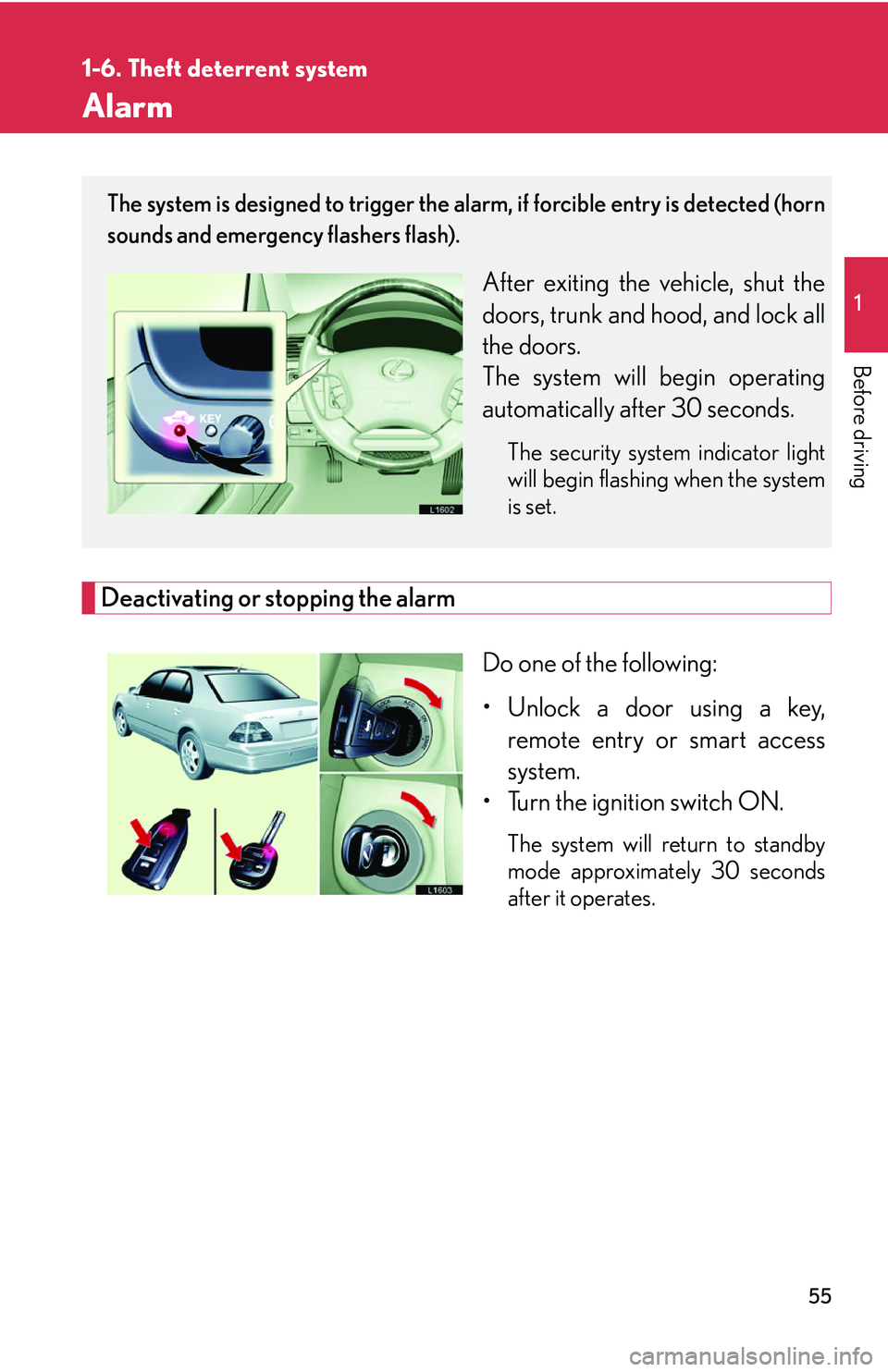
55
1
1-6. Theft deterrent system
Before driving
Alarm
Deactivating or stopping the alarm
Do one of the following:
• Unlock a door using a key, r
emote entry or smart access
system.
• Turn the ignition switch ON.
The system will return to standby
mode approximately 30 seconds
after it operates.
The system is designed to trigger the alarm, if forcible entry is detected (horn
sounds and emergency flashers flash).
After exiting the vehicle, shut the
doors, trunk and hood, and lock all
the doors.
The system will begin operating
automatically af
ter 30 seconds.
The security system indicator light
will begin flashing when the system
is set.
Page 72 of 419
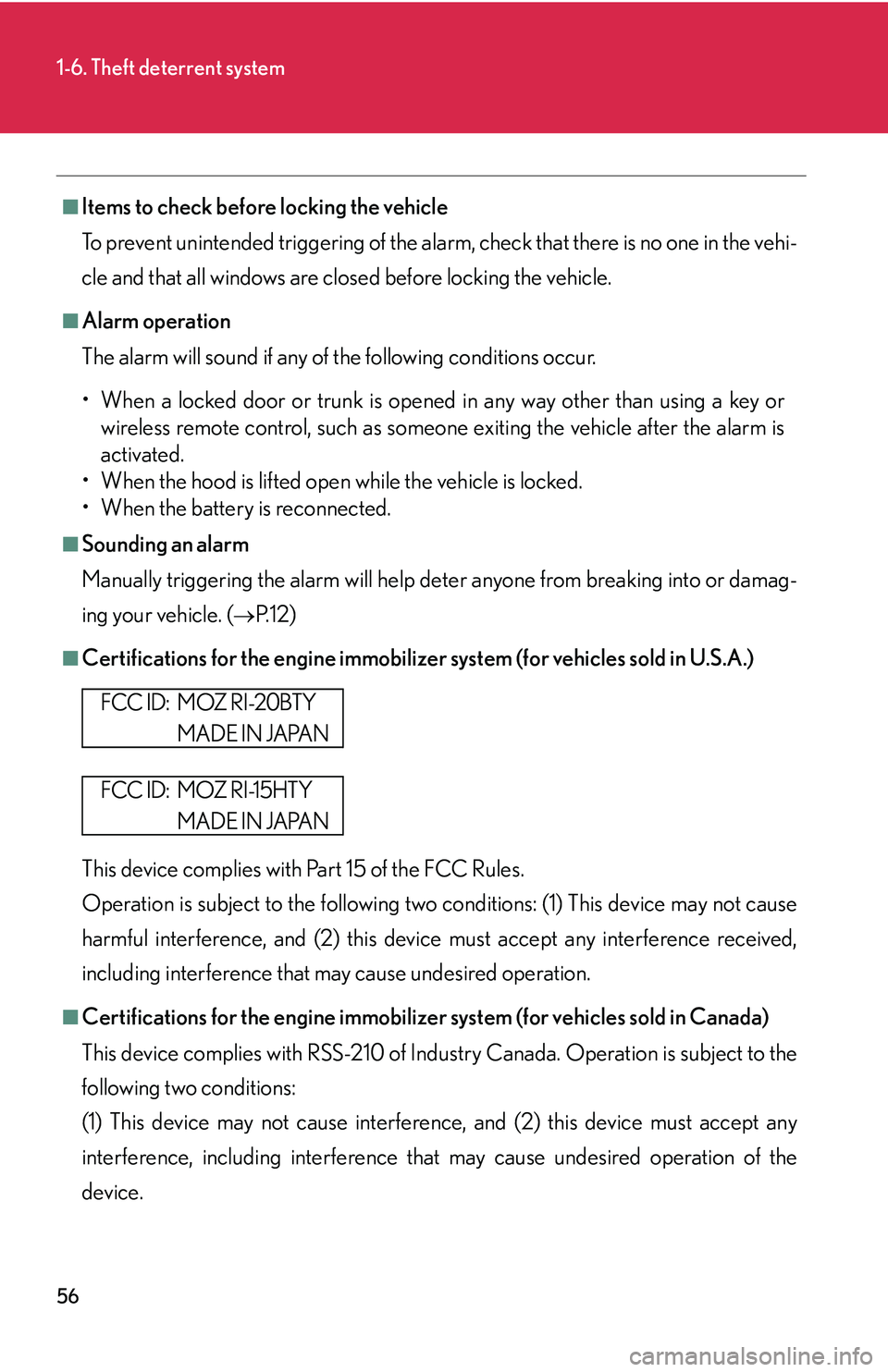
56
1-6. Theft deterrent system
■Items to check before locking the vehicle
To prevent unintended triggering of the alarm
, check that there is no one in the vehi-
cle and that all windows are clos ed bef
ore locking the vehicle.
■Alarm operation
The alarm will sound if any of the following conditions occur.
• When a locked door or trunk is opened in any way other than using a key or
wir
eless remote control, such as someone exiting the vehicle after the alarm is
activated.
• When the hood is lifted open while the vehicle is locked.
• When the battery is reconnected.
■Sounding an alarm
Manually triggering the alarm will help de ter an
yone from breaking into or damag-
ing your vehicle. (
P. 12 )
■Certifications for the engine immobilizer system (for vehicles sold in U.S.A.)
This device complies with Part 15 of the FCC Rules.
Operation is subject to the following two co
nditions: (1) This device may not cause
harmful interference, and (2) this device must accept any interference received,
including interference that may cause undesired operation.
■Certifications for the engine immobilizer system (for vehicles sold in Canada)
This device complies with RSS-210 of Indu str
y Canada. Operation is subject to the
following two conditions:
(1) This device may not cause interference, and (2) this device must accept any
inter
ference, including interference that may cause undesired operation of the
device.
FCC ID: MOZ RI-20BTY
MADE IN JAPAN
FCC ID: MOZ RI-15HTY
MADE IN JAPAN
Page 73 of 419
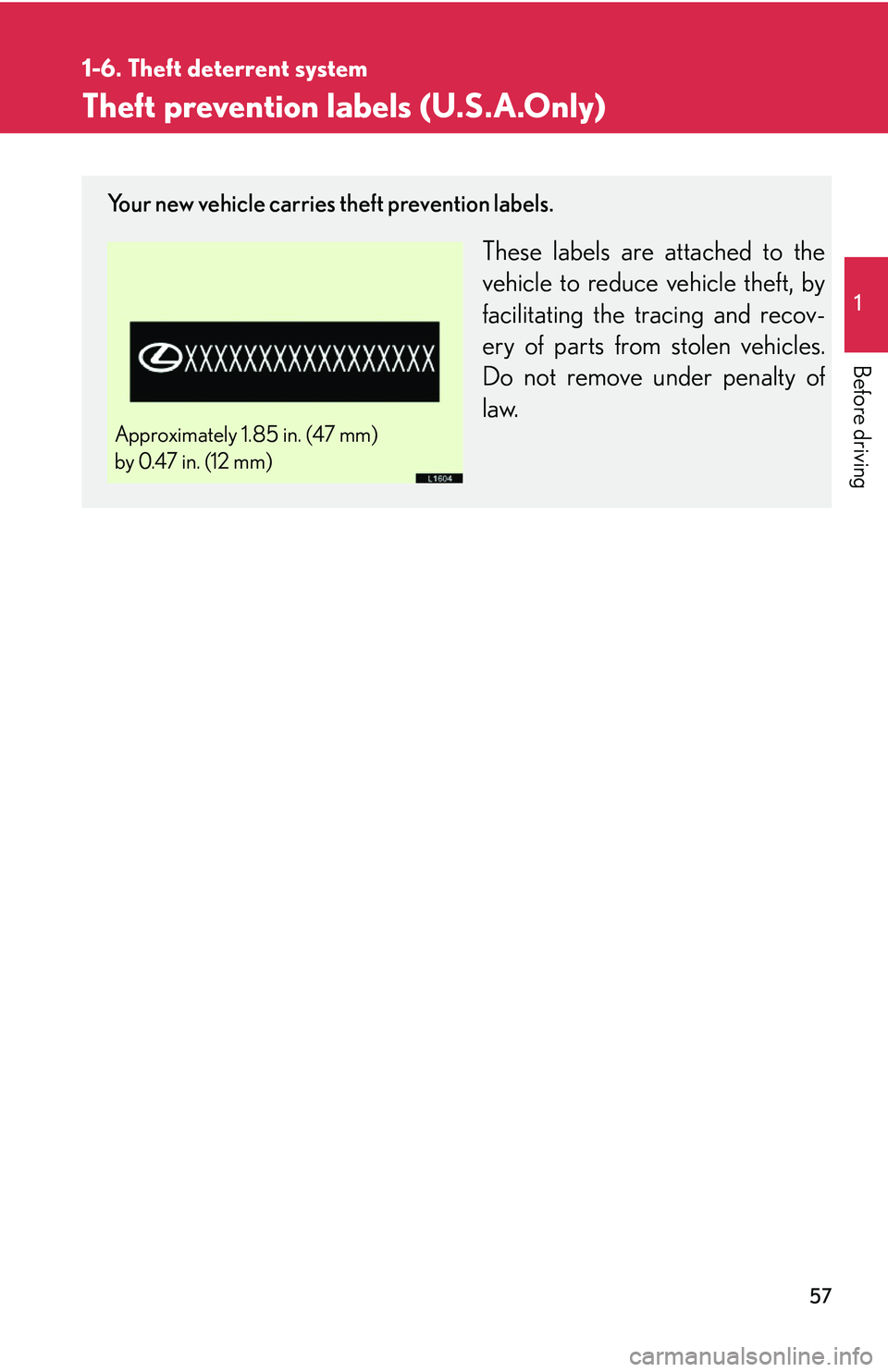
57
1
1-6. Theft deterrent system
Before driving
Theft prevention labels (U.S.A.Only)
Your new vehicle carries theft prevention labels.
These labels are attached to the
vehicle to reduce vehicle theft, by
facilitating the tracing and recov -
ery of parts from stolen vehicles.
Do not r
emove under penalty of
law.
Approximately 1.85 in. (47 mm)
by 0.47 in. (12 mm)
Page 74 of 419
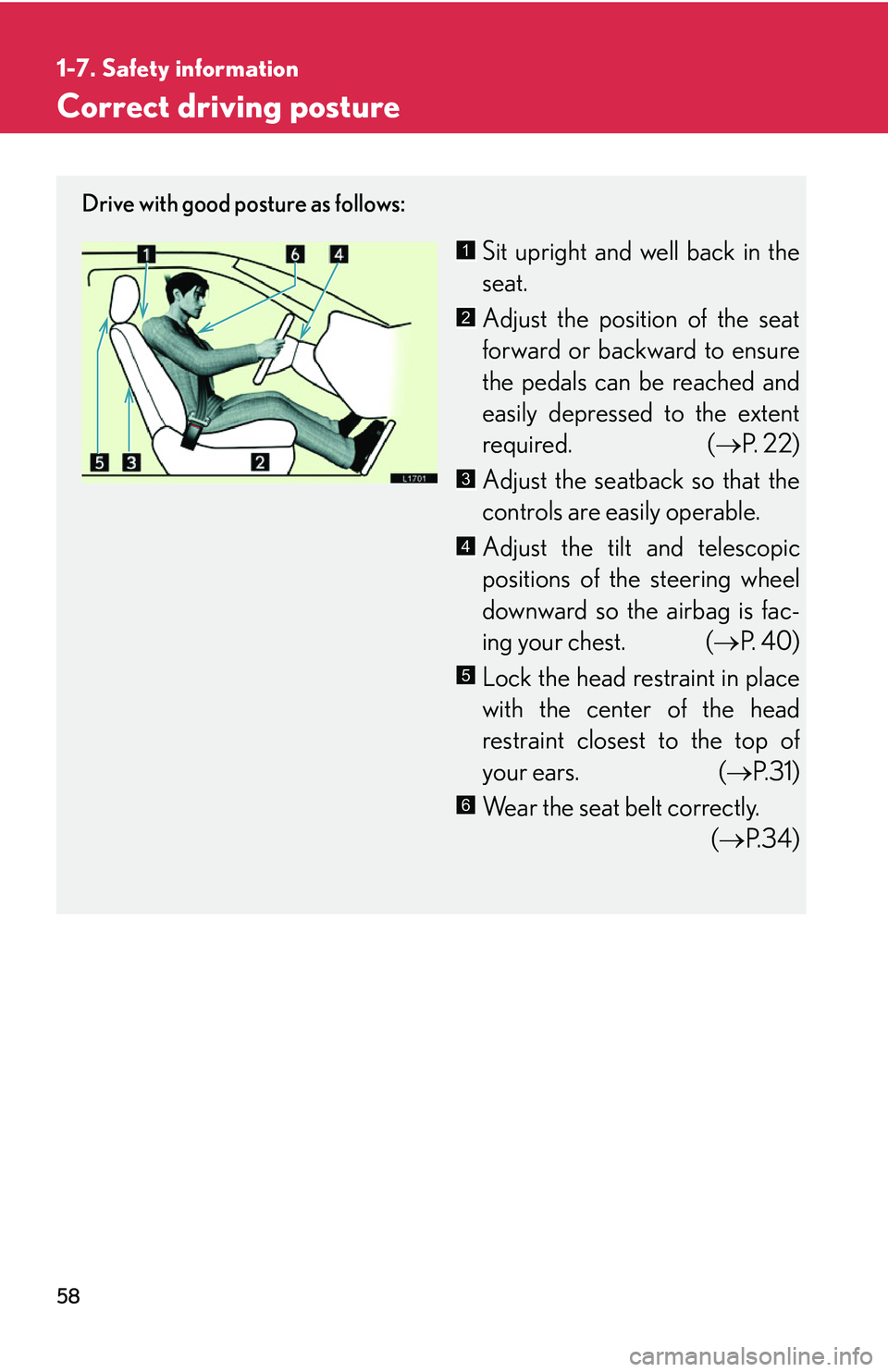
58
1-7. Safety information
Correct driving posture
Drive with good posture as follows:
Sit upright and well back in the
seat.
Adjust the position of the seat
forward or backward to ensure
the pedals can be r
eached and
easily depressed to the extent
required. ( P.
2 2 )
Adjust the seatback so that the
controls are easily operable.
Adjust the tilt and telescopic
positions of the steering wheel
do
wnward so the airbag is fac -
ing your chest. ( P.
4 0 )
Lock the head restraint in place
with the center of the head
r
estraint closest to the top of
your ears. ( P
.31)
Wear the seat belt correctly.
( P.
3 4 )
1
2
3
4
5
6
Page 75 of 419
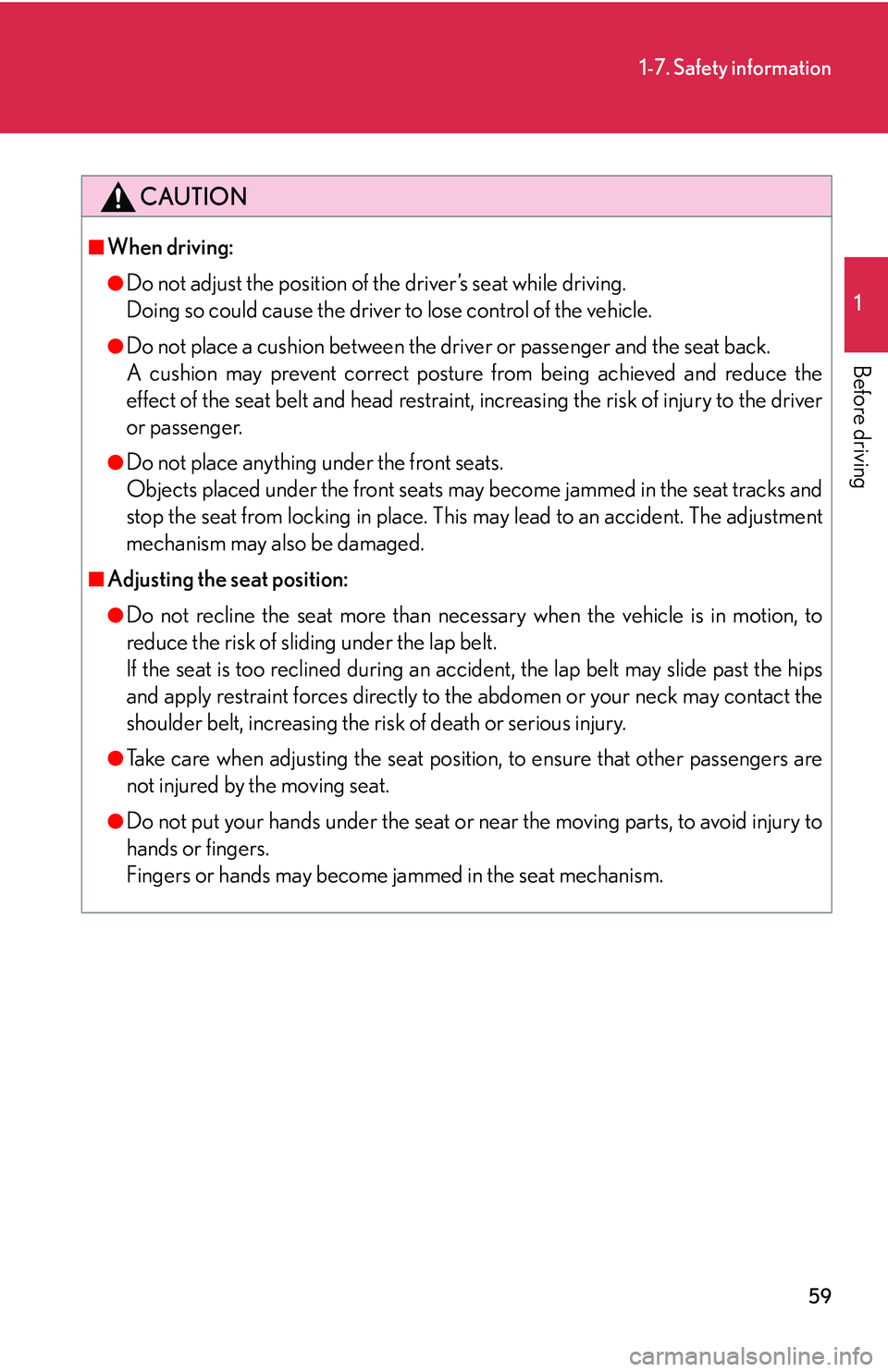
59
1-7. Safety information
1
Before driving
CAUTION
■When driving:
●Do not adjust the position of the driver’s seat while driving.
Doing so could cause the driver to lose control of the vehicle.
●Do not place a cushion between the driv er or passenger and the seat back.
A cushion may prevent correct posture from being achieved and reduce the
ef
fect of the seat belt and head restraint, increasing the risk of injury to the driver
or passenger.
●Do not place anything under the front seats.
Objects placed under the front seats may become jammed in the seat tracks and
sto
p the seat from locking in place. This may lead to an accident. The adjustment
mechanism may also be damaged.
■Adjusting the seat position:
●Do not recline the seat more than necessary when the vehicle is in motion, to
reduce the risk of sliding under the lap belt.
If the seat is too reclined during an accident, the lap belt may slide past the hips
and
apply restraint forces directly to th e abdomen or your neck may contact the
shoulder belt, increasing the risk of death or serious injury.
●Take care when adjusting the seat positi on, to ensure that other passengers are
not injured by the moving seat.
●Do not put your hands under the seat or ne ar the moving parts, to avoid injury to
hands or fingers.
Fingers or hands may become ja
mmed in the seat mechanism.
Page 76 of 419
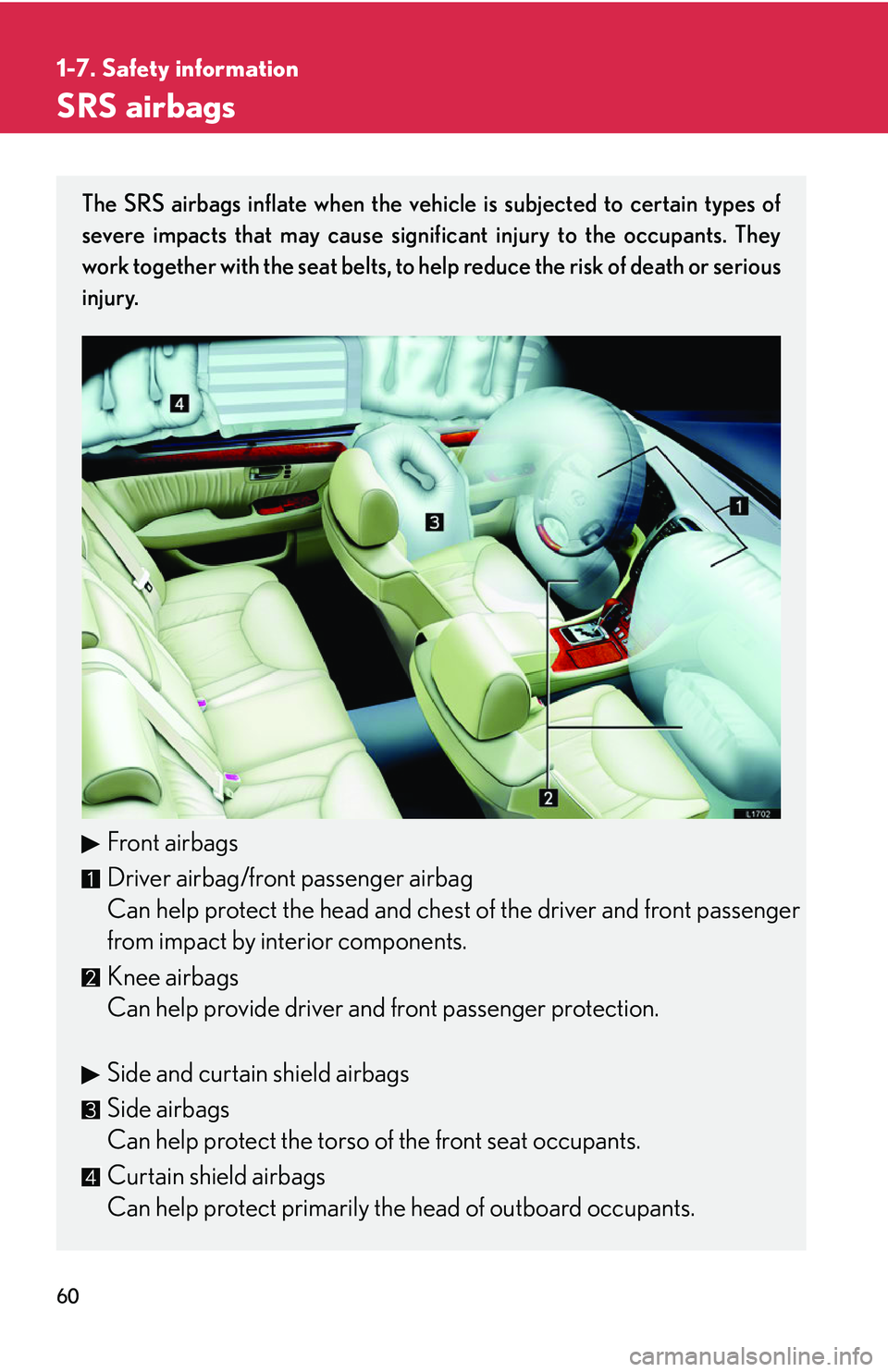
60
1-7. Safety information
SRS airbags
The SRS airbags inflate when the vehicle is subjected to certain types of
severe impacts that may cause significant injury to the occupants. They
work together with the seat belts, to help reduce the risk of death or serious
injury.
Front airbags
Driver airbag/front passenger airbag
Can help protect the head and chest of the driver and front passenger
fr
om impact by interior components.
Knee airbags
Can help provide driver and front passenger protection.
Side and curtain shield airbags
Side airbags
Can help protect the torso of the fr
ont seat occupants.
Curtain shield airbags
Can help protect primarily the head of ou
tboard occupants.
Page 77 of 419
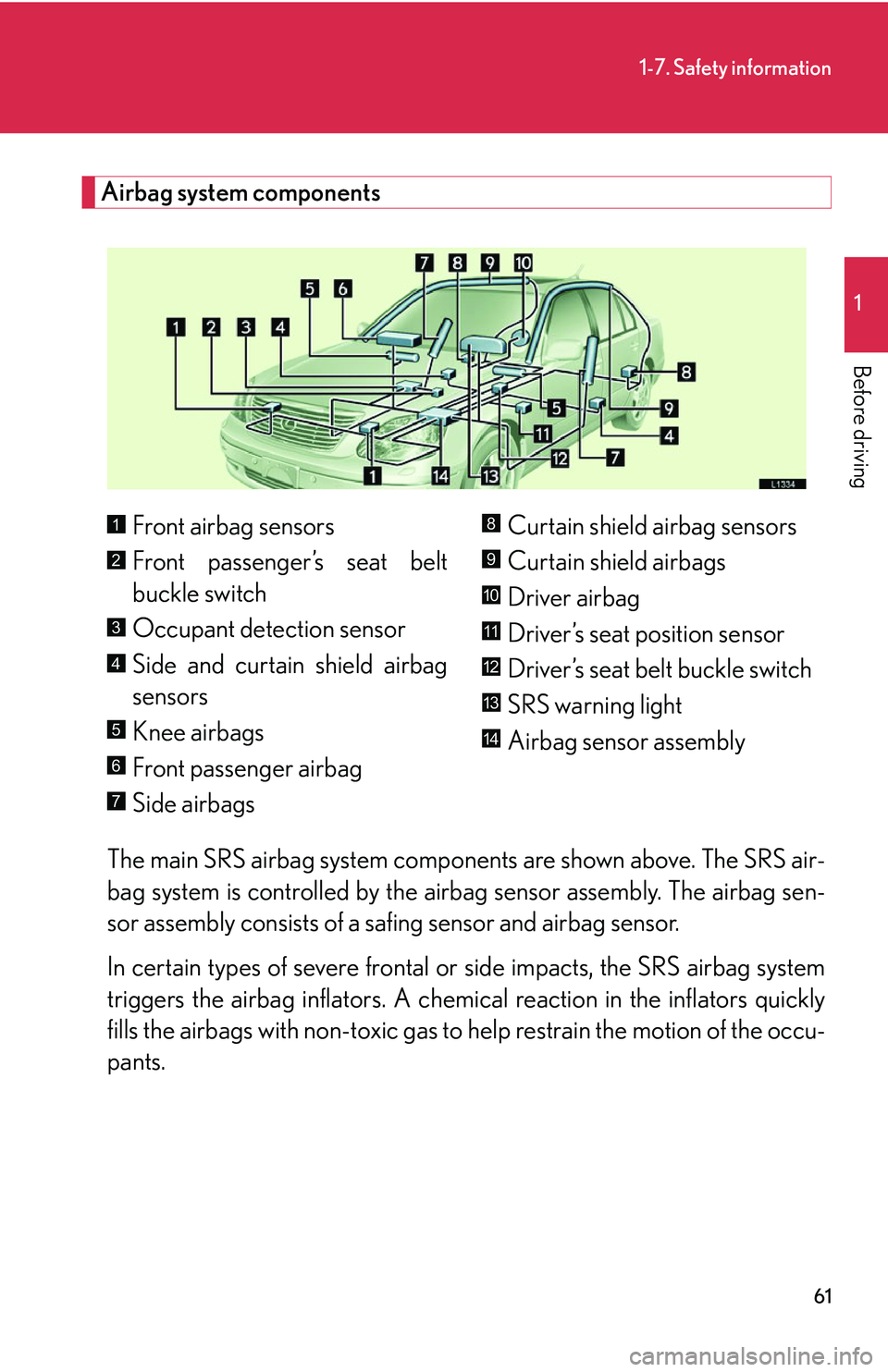
61
1-7. Safety information
1
Before driving
Airbag system components
The main SRS airbag system components are shown above. The SRS air-
bag system is controlled by the airb ag sensor as
sembly. The airbag sen-
sor assembly consists of a safing sensor and airbag sensor.
In certain types of severe frontal or side impacts, the SRS airbag s
ystem
triggers the airbag inflators. A chemica l reaction in the inflators quickly
fills the airbags with non-toxic gas to help restrain the motion of the occu -
pants. Front airbag sensors
Front passenger’s seat belt
buckle switch
Occupant detection sensor
Side and curtain shield airbag
sensors
Knee airbags
Front passenger airbag
Side airbags
Curtain shield airbag sensors
Curtain shield airbags
Driver airbag
Driver’s seat position sensor
Driver’s seat belt buckle switch
SRS warning light
Airbag sensor assembly
1
2
3
4
5
6
7
8
9
10
11
12
13
14
Page 78 of 419
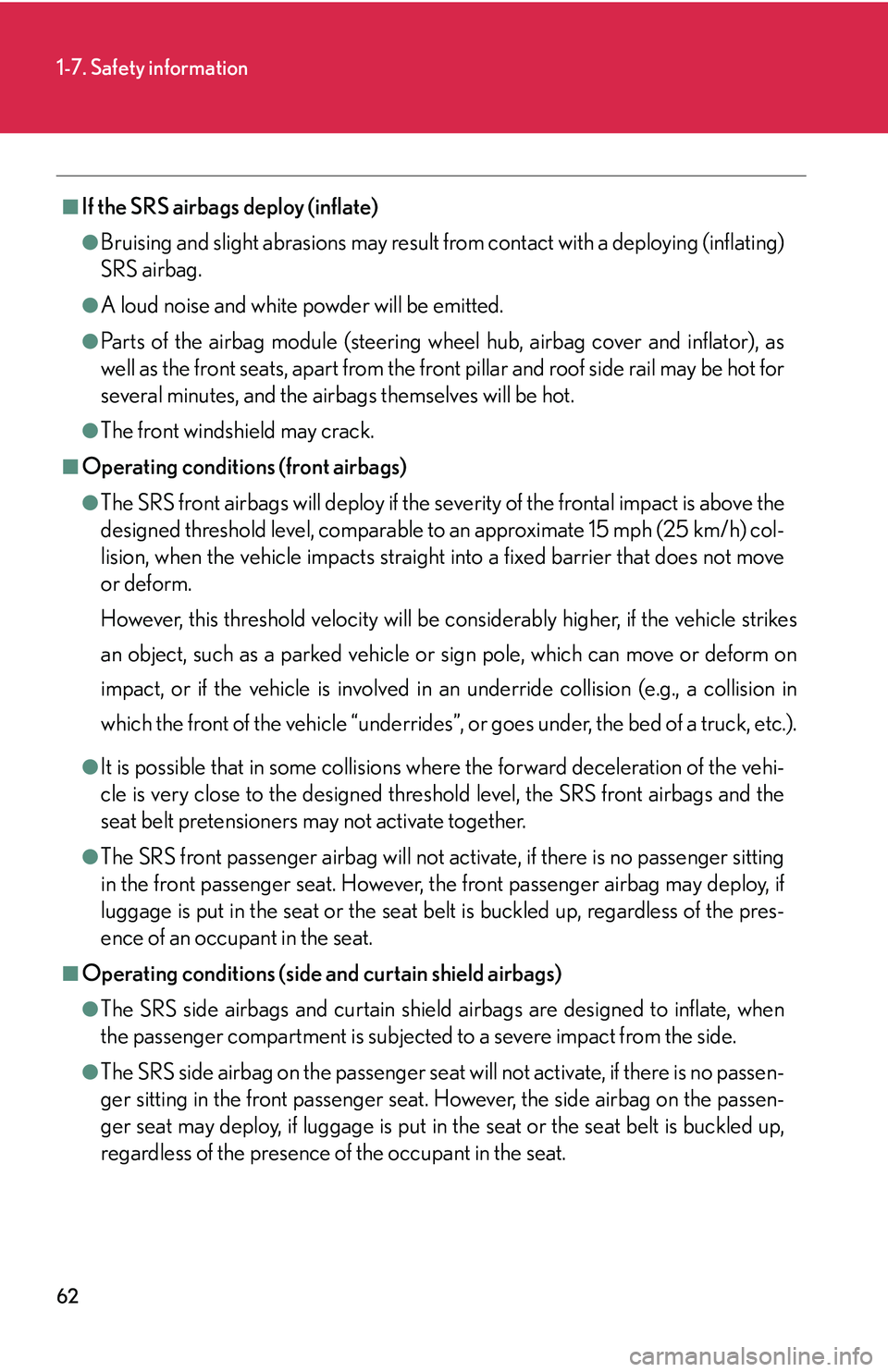
62
1-7. Safety information
■If the SRS airbags deploy (inflate)
●Bruising and slight abrasions may result from contact with a deploying (inflating)
SRS airbag.
●A loud noise and white powder will be emitted.
●Parts of the airbag module (steering whee l hub, airbag cover and inflator), as
well as the front seats, apart from the front pillar and roof side rail may be hot for
several minutes, and the airbags themselves will be hot.
●The front windshield may crack.
■Operating conditions (front airbags)
●The SRS front airbags will deploy if the severity of the frontal impact is above the
designed threshold level, comparable to an approximate 15 mph (25 km/h) col -
lision, when the vehicle imp acts
straight into a fixed barrier that does not move
or deform.
However, this threshold velocity will be considerably higher, if the vehicle strikes
a
n object, such as a parked vehicle or sign pole, which can move or deform on
impact, or if the vehicle is involved in an underride collision (e.g., a collision in
which the front of the vehicle “underrides”, or goes under, the bed of a truck, etc.).
●It is possible that in some collisions where the forward deceleration of the vehi -
cle is very close to the designed thresh ol
d level, the SRS front airbags and the
seat belt pretensioners ma y not activate together.
●The SRS front passenger airbag will not activate, if there is no passenger sitting
in the front passenger seat. However, th e front passenger airbag may deploy, if
luggage is put in the seat or the seat belt is buckled up, regardless of the pres -
ence of an occupant in the seat.
■Operating conditions (side and curtain shield airbags)
●The SRS side airbags and curtain shield airbags are designed to inflate, when
the passenger compartment is subjected to a severe impact from the side.
●The SRS side airbag on the passenger seat will not activate, if there is no passen -
ger sitting in the front passenger seat. Ho
wever, the side airbag on the passen-
ger seat may deploy, if luggage is put in the seat or the seat belt is buckled up,
r
egardless of the presence of the occupant in the seat.
Page 79 of 419
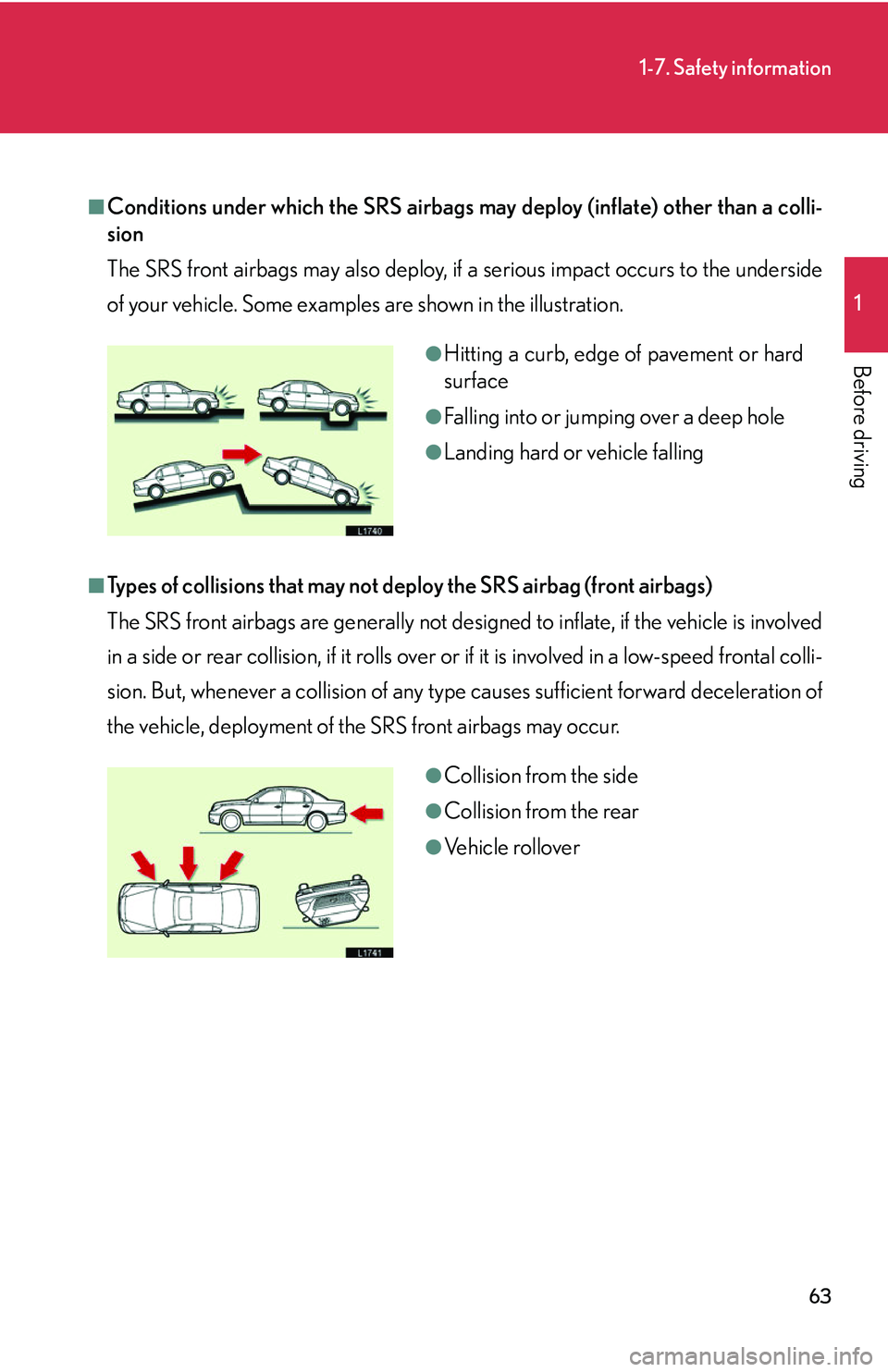
63
1-7. Safety information
1
Before driving
■Conditions under which the SRS airbags may deploy (inflate) other than a colli-
sion
The SRS front airbags may also deploy, if a se
rious impact occurs to the underside
of your vehicle. Some examples are shown in the illustration.
■Types of collisions that may not de ploy the SRS airbag (front airbags)
The SRS front airbags are generally not designed to inflate, if the vehicle is involved
i
n a side or rear collision, if it rolls over or if it is involved in a low-speed frontal colli -
sion. But, whenever a collision of any type c
auses sufficient forward deceleration of
the vehicle, deployment of th e SRS front airbags may occur.
●Hitting a curb, edge of pavement or hard
surface
●Falling into or jumping over a deep hole
●Landing hard or vehicle falling
●Collision from the side
●Collision from the rear
●Vehicle rollover
Page 80 of 419
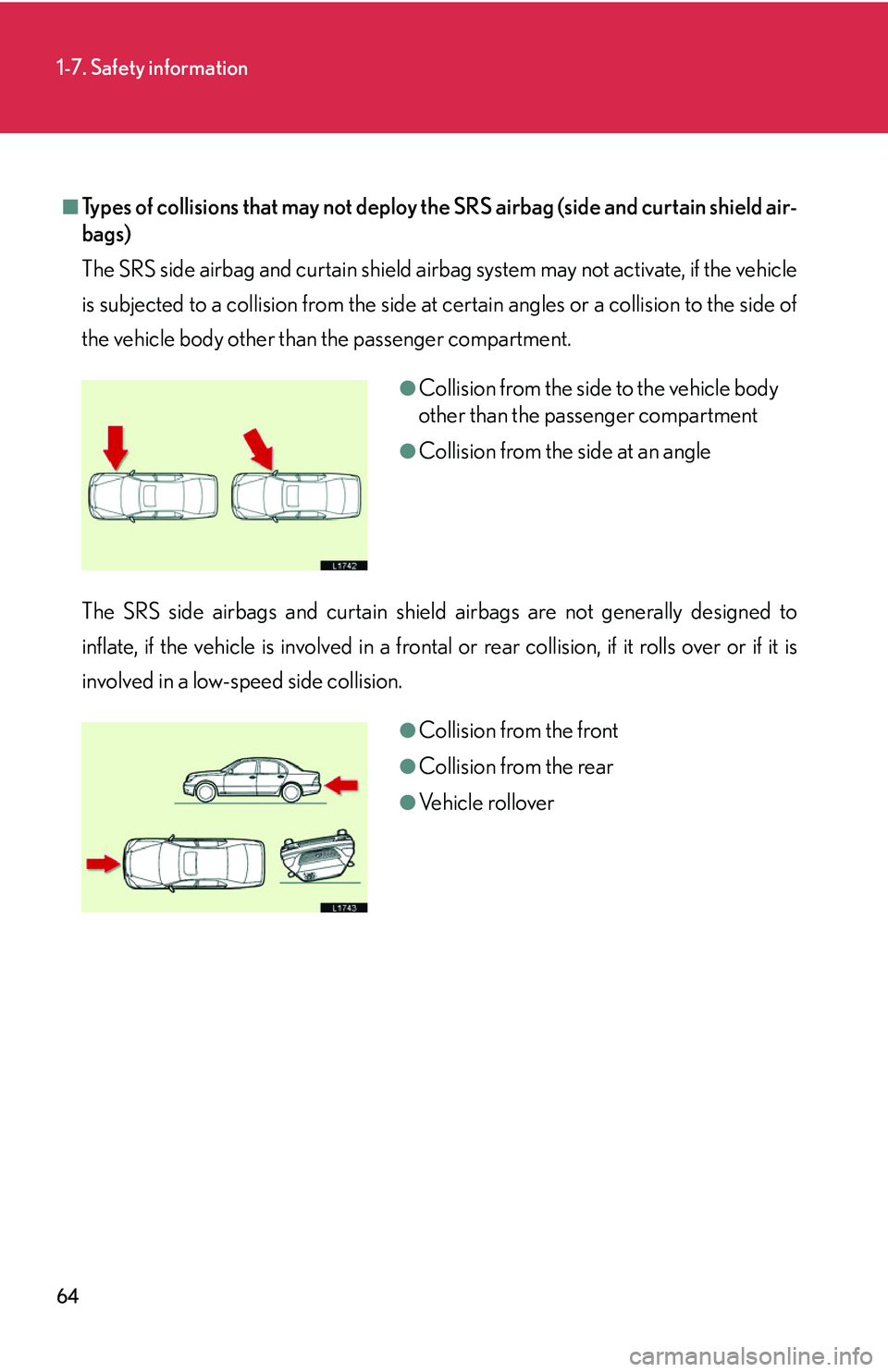
64
1-7. Safety information
■Types of collisions that may not deploy the SRS airbag (side and curtain shield air-
bags)
The SRS side airbag and curtain shield airbag system may not activate, if the vehicle
is
subjected to a collision from the side at certain angles or a collision to the side of
the vehicle body other than the passenger compartment.
The SRS side airbags and curtain shield airbags are not generally designed to
infl
ate, if the vehicle is involved in a frontal or rear collision, if it rolls over or if it is
involved in a low-speed side collision.
●Collision from the side to the vehicle body
other than the passenger compartment
●Collision from the side at an angle
●Collision from the front
●Collision from the rear
●Vehicle rollover